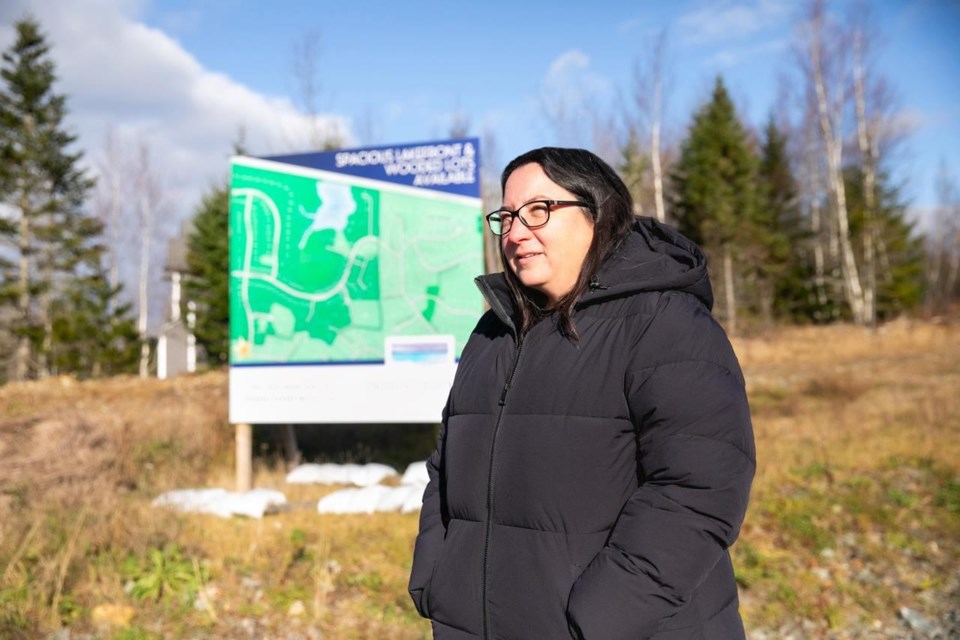HALIFAX — As she stood outside her Halifax home recently and recalled the acrid smoke that filled the horizon last spring, Antoniella Assalone wondered whether she will have a safe escape route if another wildfire comes.
Her property in the Indigo Shores subdivision is one example of the city's dilemma: houses on the capital's outskirts butt up against combustible forests, and there's often just one road out — potentially creating traffic jams and panic during an evacuation.
"We're worried about the spring and summer. It would be nice to have (an emergency) exit before then. Why would we wait until July?" she said in an interview.
On May 28, Assalone and her 12-year-old daughter were among the 16,000 city residents forced from their homes as fires ignited in Upper Tantallon and Hammonds Plains, burning 151 homes.
More than five months later, she stood near an empty lot a few hundreds metres from her residence, within sight of an old landfill that backs onto a provincial highway, making the case that it could provide a way out for future emergencies.
"All we need is gravel. Just fix the road .... We pay enough taxes, give us a second exit," she said.
Indigo Shores is one of 10 Halifax communities without a second exit — referred to as "secondary egress" — on a list compiled by Erica Fleck, Halifax's director of emergency management, and received by The Canadian Press through a freedom of information request.
The city's media relations department and Fleck declined interviews on the issue, saying staff are working on providing council with a series of reports on potential exits, and interviews are not being provided until the work is complete.
However, citizens who lost homes or saw their neighbourhoods devastated are looking for lasting solutions and more information.
Amanda Lutz, whose home was destroyed during the fires, said in an interview last week that when she and her husband return to their rebuilt residence in the Highland Park area, she wants the city to have a clear plan that includes safer evacuation routes.
One emergency exit was added to her neighbourhood in June, giving it additional access to the main connector road in the area. However, Lutz, a member of the Tantallon Wildfire Life Safety Coalition, said this narrow route out presents its own risks, as an evacuation could create a deluge of traffic onto the two-lane road.
"We need rear exits (from the community)," she said, standing at the site where her home is being rebuilt. "We're going to need connections along the back of the community to get us to other exits." She also wants to see a timeline. "When are (governments) going to get this done?" the 33-year-old lawyer asked.
Pam Lovelace, the councillor for the district where the fires occurred, refers to the subdivision as a series of "balloon" communities, crafted by developers to appeal to those seeking quiet crescent streets with one road in and out and little traffic passing through.
However, she said a 2017 Department of Natural Resources study showed much of her district northwest of downtown is at either high or extreme risk from wildfires, and change is urgently needed.
Sitting in front of a digital map, she points to some of the disconnected neighbourhoods that fires tore through, saying it's now evident that a "community connector" road is needed to allow motorists a second route to the provincial highways.
The councillor acknowledges there are challenges, as the city is faced with buying private lands at a reasonable price, and funding must be found to build the new road.
"There are other councillors who may feel their communities should be prioritized over my community, and then you get into a bun fight. And so I think there needs to be ... some kind of criteria put in place to identify who needs this most urgently," she said.
A motion she and Coun. Waye Mason brought in August asked city staff to prepare a "prioritized" list of communities that require emergency exits, along with a list of requests for the province to use its Crown lands. Lovelace said work on the reports is underway, with completion expected by the spring of 2024.
Lovelace also said that she doesn't believe areas like Indigo Shores should be permitted to continue expanding if emergency exit routes aren't built. However, Marc Ouellet, the senior planning manager at Armco Capital Inc., the developer of Indigo Shores, said he has not received any formal request from the city about building an extra exit.
Meanwhile, Tory Rushton, the provincial minister of Natural Resources, said that if Halifax and other municipalities begin making applications for use of Crown lands for connector roads and emergency exits, "we're not going to hinder those," but the proposal has to come from the municipality.
Assalone hopes all the talk leads to action soon. "Get it done," she said, gesturing towards the empty land where she envisions an escape route. "Talk it out, split the difference, and get it done."
This report by The Canadian Press was first published Nov. 13, 2023.
Michael Tutton, The Canadian Press



